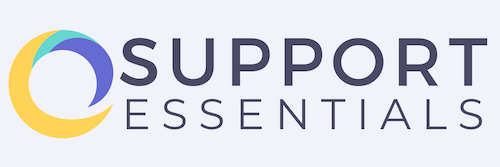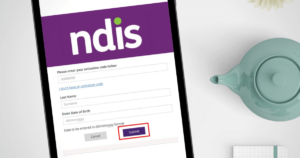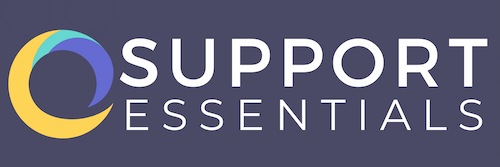Applying to the NDIS for ASD1 – How is it Different?
Autism Spectrum Disorder (ASD) is a recognised disability in Australia. It is diagnosed as per the Diagnostic and Statistical Manual of Mental Disorders, 5th Edition (DSM-V or DSM-5) which specifies three levels of severity:
Level 1 – needing support
Level 2 – needing substantial support
Level 3 – needing very substantial support
Previously we looked at the different pathways available to complete an NDIS access request for an Autistic child and discovered three different processes based on a child’s age and their ASD level of severity.
Children under the age of 7 should take the Early Childhood Early Intervention (ECEI) approach to access the NDIS.
For children aged 7 and above, the pathway to access the NDIS is different for those with ASD Level 1 (ASD1), compared to those diagnosed as Level 2 or 3.
Sometimes people are (wrongly) informed that their child with ASD1 cannot gain funding from the NDIS, and this is simply not true.
Applying to the NDIS for ASD1 requires the gathering of extra supporting evidence to meet eligibility requirements. This extra supporting evidence is not required for those with Level 2 or 3 ASD who benefit from a more streamlined access pathway. But this does not mean that gaining access to the NDIS for ASD1 is not possible, it just takes a little extra work.
This may seem a little unfair until you remember that under the previous federal Autism support package, Helping Children with Autism (HCWA), there was no funding available for any Autistic child over the age of 7.
By this measure, the NDIS offers a significant increase in the support available to children who are diagnosed with ASD when they are over 7 years of age.

What are the Requirements for Applying to the NDIS for ASD1?
Any eligible person with ASD can apply to the National Disability Insurance Scheme (NDIS). However, the NDIS has made a distinction between the different severity levels of ASD.
Here is how the NDIS eligibility requirements specifically pertain to Autism Spectrum Disorder Level 1 (ASD1).
The Age Requirements
You can access the NDIS if you are between 7 and 65 years old. Children under the age of 7 should take the Early Childhood Early Intervention (ECEI) approach to access the NDIS.
The Residency Requirements
To meet the NIDS residency requirements, you must live in Australia and be an Australian citizen or have a Permanent or Special Category Visa.
The Disability Requirements
To access the NDIS you are required to prove not only that you have a disability, but that your disability is likely to be permanent and results in substantially reduced functional capacity.
The National Disability Insurance Agency (NDIA) has created multiple lists of disabilities to streamline their process for determining the disability access requirement. ‘List B’ is one such list.
Of the disabilities listed on List B, these are the ones that pertain to Autism:
- Pervasive developmental disorders not meeting severity criteria in List A or List C
- Asperger syndrome
- Atypical autism
- Childhood autism
ASD Level 1 (ASD1) is inferred in this list as ASD1 is a Pervasive Development Disorder but does not meet the severity criteria in List A (which only specifies Level 2 and Level 3 ASD).
The NDIA also states
Where a prospective participant has been diagnosed with a condition/s on List B the NDIA will be satisfied that the person has a disability attributable to one or more impairments that is, or is likely to be, permanent without further assessment.
For prospective participants diagnosed with a condition/s on List B, the NDIA will only need to assess whether the prospective participant:
has an impairment/s that result in substantially reduced functional capacity to perform one or more activities;
has impairment/s which affect the person’s capacity for social or economic participation; and
is likely to require support under the NDIS for the person’s lifetime.
NIDS Operational Guidelines Section 8.6.2
This means the NDIA accepts that a person with ASD1 has a permanent disability but would like more information about their functional capacity in order to make a decision about whether they can access the NDIS.
The approval of an NDIS Access Request for ASD1 is dependent on convincing the NDIA that an applicant’s Autism significantly impairs their functional capacity for everyday activities and their social or economic participation.
Therefore, an applicant will need to submit with their access request not only written evidence of their diagnosis, but also written evidence of their impaired functional capacity.
If you apply to access the NDIS and are denied, you will have to wait three months before you can make another request, so it’s important to get it right.
Here are four tips for gathering the supporting evidence you need when applying to the NDIS for ASD1.
4 Tips for Applying to the NDIS for ASD1
1. Contact Your Local Area Co-Ordinator (LAC) for Help
The NDIA uses Local Area Co-Ordinators (LAC’s) to help people understand and access the NDIS.
Before you begin gathering your evidence, the best thing you can do is to make a quick phone call to your local LAC office.
Your LAC can provide you with up-to-date resources and give you tips and pointers about how to go about gathering the supporting evidence you need for your NDIS Access Request.
While LAC’s do not take part in the decision-making process to grant or deny NDIS access requests, they see many requests go through their office and over time can get a feel for which requests are likely to be successful and which are not.
Save yourself some time and energy by taking advantage of their expertise when applying to the NDIS for ASD1.
2. Provide Supporting Evidence as per the NDIA’s Specifications
Make sure your proof of diagnosis and supporting evidence is as per the NDIS’s specifications. The NIDS website provides guidance as to which evidence is the best for each primary diagnosis. When applying to the NDIS for ASD1, you need to ensure you are using the correct evidence for the primary diagnosis of Autism.
Proof of Diagnosis
For an Autism diagnosis, the following assessments (in order of preference) are good disability evidence:
- Diagnostic and statistical manual of mental disorders, fifth edition (DSM-V)
- Vineland adaptive behavior scale (Vineland-II)
- World Health Organisation disability assessment schedule (WHODAS) 2.0 (17 years and over) or
- PEDI-CAT (16 years and under).
Be sure to include copies of the reports from any of the above assessments when applying to the NDIS for ASD1 (the more the better).
If you obtained a private diagnosis, it will also work in your favour if you have been diagnosed by an NDIS approved provider.
Proof of Impaired Functional Capacity
The NDIS website states that the best evidence to support the NDIA to make a decision about your eligibility for the NDIS is:
- recent
- completed by a treating health professional who is relevant to your primary disability
- confirms your primary disability
- confirms the impacts of your disability on the different areas of your life
- describes previous treatments and outcomes
- describes future treatment options and expected outcomes of those treatments.
- Primary disability refers to the impairment that impacts most on your daily functioning.
It also states that for the primary disability of Autism, the most appropriate treating health professionals are:
- Psychologist
- Occupational Therapist
- Speech Therapist
These are the treating health professionals that you are most likely to receive funding for if you are granted access to the NDIS.
If you feel that you don’t need the support of these specific treating health professionals, then maybe you should look at accessing services other than the NDIS for support.
If you are already utilising the services of a Psychologist, Occupational Therapist and/or Speech Therapist, approach them and ask them to write a report to support your request for access to the NDIS.
Be sure to share with them the best evidence that the NDIA is looking for (as specified above) for them to include in their report.
If you don’t currently see any of the above treating health professionals, think about which of those services you would wish to utilise if you were to gain access to the NDIS and approach those professionals about obtaining the appropriate assessments and reports.
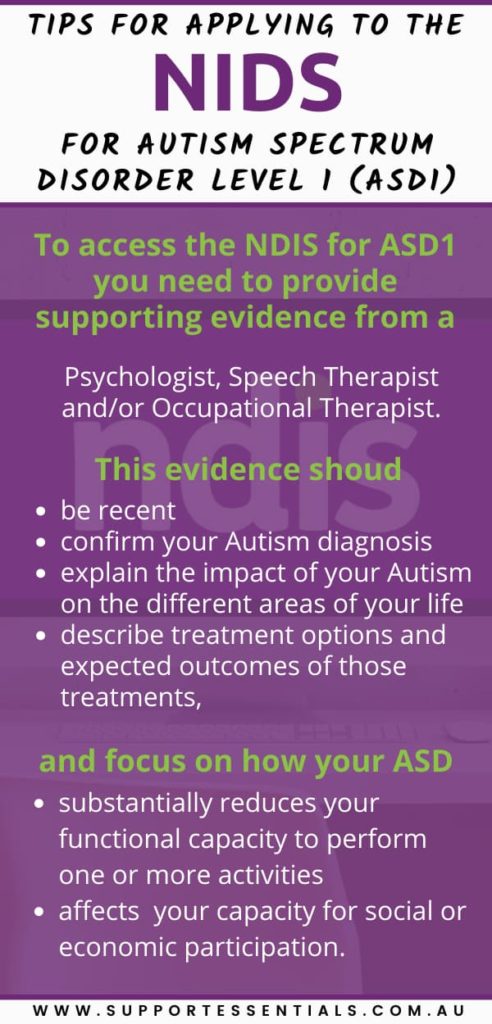
3. Don’t Let A Lack of Funds Hold You Back
Accessing treating health professionals for assessments and reports will come at a cost and unfortunately, these costs are not able to be claimed under the NDIS even if you are a successful applicant.
But please don’t let a lack of funds hold you back. If you feel you genuinely need support from a Psychologist, Speech Therapist or Occupational Therapist in order to improve your functional capacity for everyday activities, and to increase your social and economic participation in your community, then investing in your application to access the NDIS will get you the help you need.
Be upfront with your treating health professionals and tell them that you are looking for supporting evidence for an NDIS Access Request.
Find out in advance how much they will charge to write a report or letter of support. Reports should cost between $200 and $400 depending on the professional (Psychologists are generally higher than Speech Therapists or Occupational Therapists).
If you feel their report writing charge is excessive then shop around for a better price or let them know what your budget is and ask them whether they can write an adequate report for that amount.
You can also investigate getting some financial assistance. Here are a few options for subsidising any costs you may incur.
The Carer’s Allowance
If you are the carer of a child diagnosed with Autism, you can apply to the Department of Human Services for a Carer’s Allowance. This is a small fortnightly income supplement plus an annual top-up payment (paid yearly in July).
The annual top up payment is especially useful for funding the costs of assessments and reports from treating health professionals. You can schedule appointments for late July with your treating health professionals in advance, so you are ready to go as soon as that top up payment arrives.
Alternatively you can save up your carer’s allowance payments until you have enough, or use them to subsidise the cost of your appointments as you go.
Medicare
Medicare does not usually offer rebates for allied health services (ie Psychology, Occupational Therapy and Speech Therapy). However there are special programs available for people with life-long conditions such as Autism.
These are usually limited to a certain number of sessions per year, or even over a lifetime.
A small amount of treatment is all that is available, but sometimes, for individuals with ASD1, a small amount of therapy can go a long way to improving their functional capacity and setting them up for success in the future.
These special Medicare rebates will not cover the reports you need as supporting evidence to access the NDIS, but it is a way to access these services to see if they are a good treatment option for someone with ASD1. Then you and your treating health professional can work towards accessing the NDIS if you both agree that it is appropriate.
Talk to your GP or your child’s Paediatrician about Medicare Rebates for Allied Health Services.
Private Health Insurance
If you are fortunate enough to have private health insurance, then you should definitely make sure you are using it to your best advantage.
Extras cover can include Psychology, Occupational Therapy or Speech therapy, but differs depending on the type of cover you have. Fortunately today, health insurance companies are making their plans flexible and giving you the option to swap certain services you do need for those you don’t.
Call or visit your health insurance provider to ensure you have cover for your preferred treating health professionals before approaching them to help you access the NDIS.
Again, the cost of reports will not be covered, but you can get significant saving off the normal appointments and assessments you will need before the treating health professional writes their report.
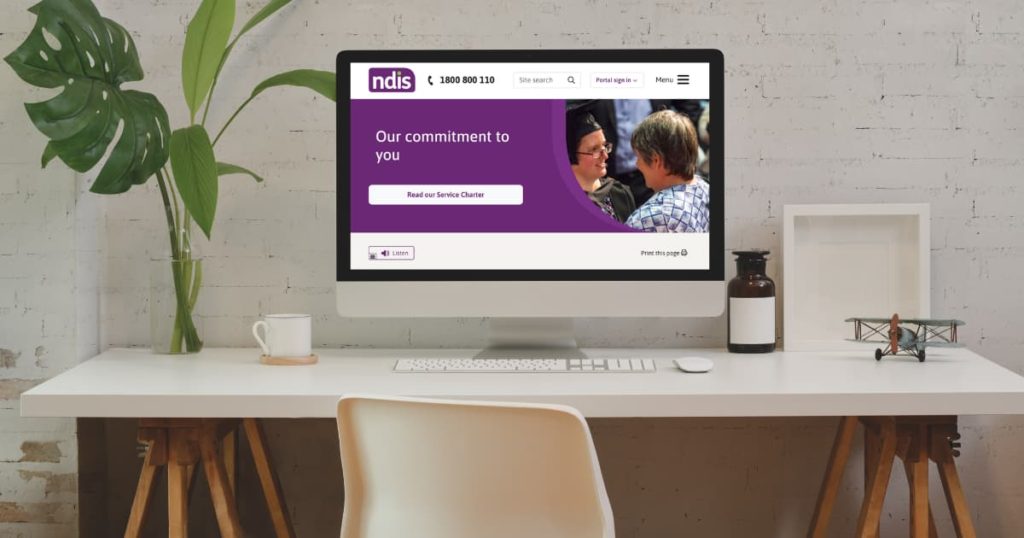
4. Keep the Focus on the Primary Disability – Autism
It is important to remember when gathering your supporting evidence for applying to the NDIS for ASD1 that it relates solely to the primary disability of Autism.
It is common for those with Autism to have other co-morbid conditions such as Attention Deficit Hyperactivity Disorder (ADHD) or Sensory Processing Disorder (SPD).
These disorders can also heavily impact your functioning capacity for everyday activities, but unfortunately, they are not disabilities that you can receive support for under the NDIS.
If your supporting evidence references the impact of these conditions on your everyday life more than the impact of your Autism, then you may find that you are denied access to the NDIS (even though you have evidence of substantially reduced functional capacity) simply because you did not tie it back to your Autism.
So it’s important to keep to these criteria when applying to the NDIS for ASD1 and to remember the specifics of what the NDIA is trying to assess.
Here is a reminder:
For prospective participants diagnosed with a condition/s on List B, the NDIA will only need to assess whether the prospective participant:
has an impairment/s that result in substantially reduced functional capacity to perform one or more activities;
has impairment/s which affect the person’s capacity for social or economic participation; and
is likely to require support under the NDIS for the person’s lifetime.
NIDS Operational Guidelines Section 8.6.2
How to Complete an NDIS Access Request for ASD1
Once you have gathered all of your supporting evidence, contact your local LAC office again and ask for an appointment to complete an NDIS Access Request.
Your LAC will help you complete the access request form and organise your supporting evidence. Your LAC can submit your access request to the NDIS on your behalf.
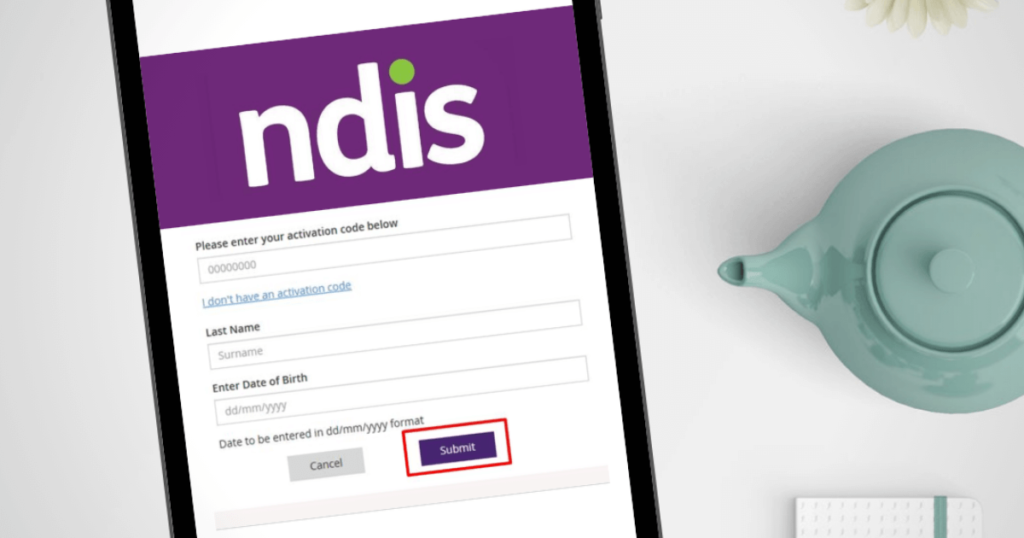
Future Changes for Applying to the NDIS for ASD1
In September 2020 the NDIS announced the introduction of Independent Assessments as part of the access process from early 2021. When applying to the NDIS for ASD1, an independent assessment will mean you don’t need to organise an assessment or collect evidence to show the impact of your disability, saving you time and money.
If a lack of funds is significantly affecting your ability to collect the supporting evidence you need from treating health professionals, then you may want to consider waiting until 2021 for a free independent assessment to determine if you can access the NDIS.
